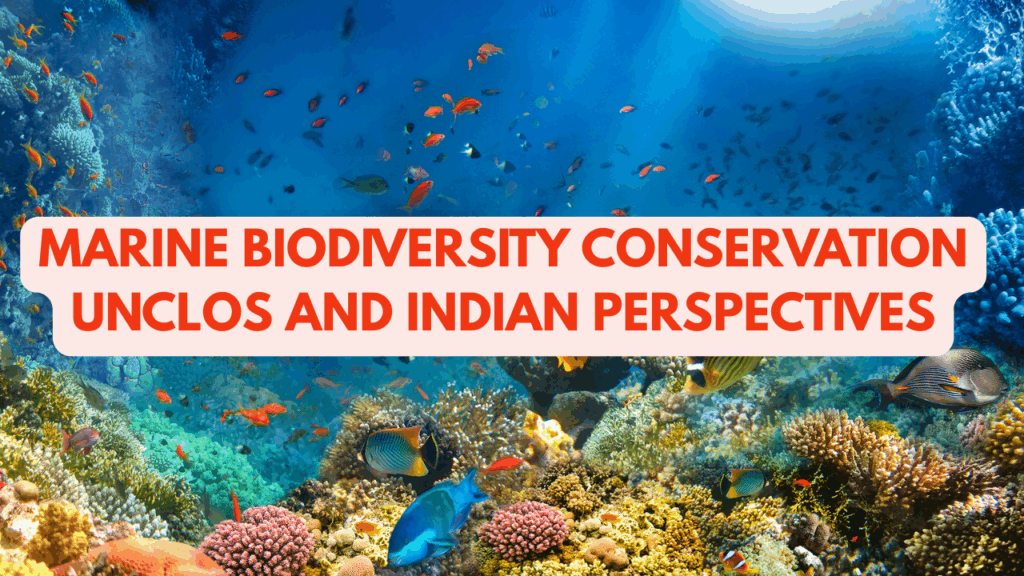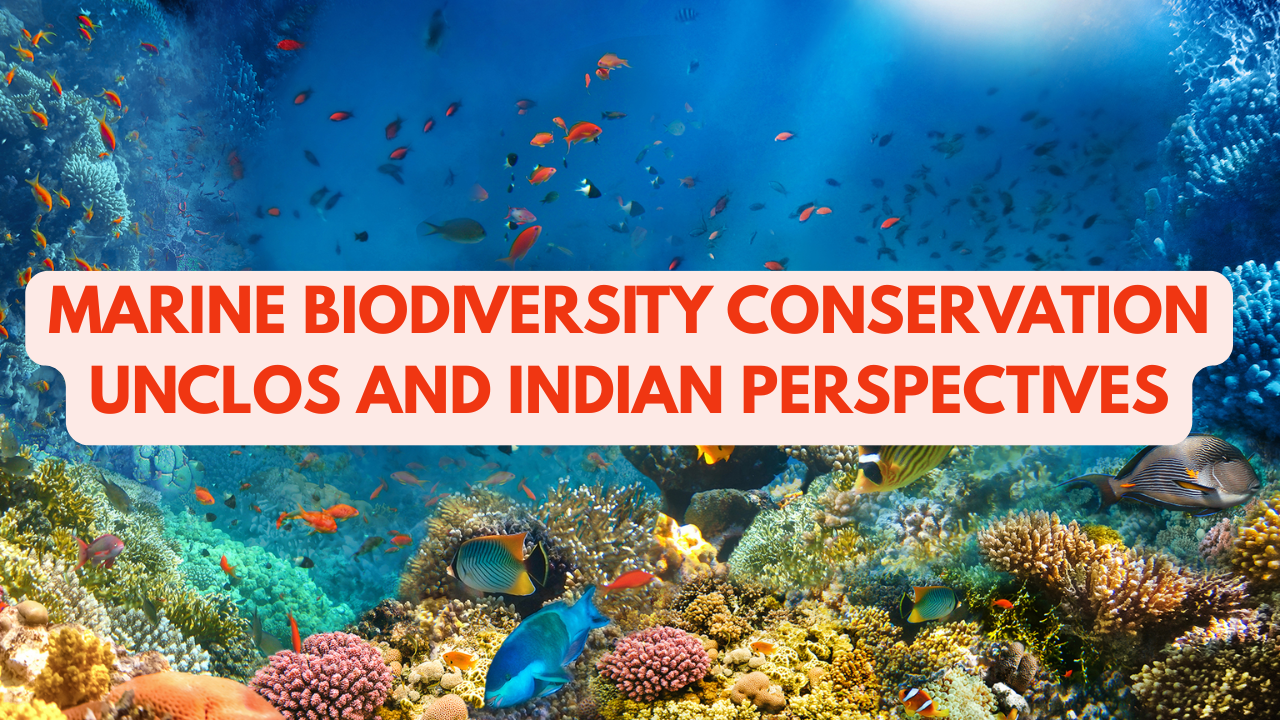
Marine biodiversity is a cornerstone of global ecological balance, providing food, livelihoods, and climate stability. Covering over 70% of the Earth’s surface, oceans are home to countless species and ecosystems. However, unsustainable exploitation, overfishing, and climate change have placed marine life under severe stress. To address these concerns, international frameworks like the United Nations Convention on the Law of the Sea (UNCLOS) and national efforts by countries such as India play a vital role in marine biodiversity conservation.
Importance of Marine Biodiversity
- Ecological Role – Maintains balance in ocean ecosystems through food webs and nutrient cycling.
- Economic Value – Fisheries, shipping, oil and gas, and tourism rely heavily on marine ecosystems.
- Climate Regulation – Oceans absorb nearly one-third of global carbon emissions.
- Livelihoods – Millions of fisherfolk and coastal communities depend directly on marine resources.
UNCLOS and Marine Biodiversity
UNCLOS, adopted in 1982, is often called the “Constitution of the Oceans”. It establishes legal frameworks for the conservation and sustainable use of marine resources.
Key Provisions under UNCLOS
- Territorial Waters & Exclusive Economic Zone (EEZ): Coastal states can exploit marine resources up to 200 nautical miles.
- Conservation of Living Resources: States must manage fish stocks sustainably.
- Protection of Marine Environment: Requires states to prevent pollution from ships, industries, and land-based sources.
- Marine Scientific Research: Promotes research cooperation to protect biodiversity.
- High Seas Governance: Ensures resources beyond EEZ are managed for the benefit of all humanity.
UNCLOS and Marine Biodiversity Beyond National Jurisdiction (BBNJ)
- Recognizes the need for protecting areas beyond national control.
- Negotiations under the BBNJ Treaty are developing new mechanisms for marine genetic resources, environmental impact assessments, and area-based management tools.
Indian Perspectives on Marine Biodiversity
India, with a coastline of 7,500 km and an EEZ of over 2 million sq. km, has significant marine resources. Its approach combines international obligations under UNCLOS with domestic legislation and policies.
Key Legal and Policy Measures in India
- Wildlife Protection Act, 1972
- Provides protection to endangered marine species like sea turtles, dugongs, and dolphins.
- Establishes Marine Protected Areas (MPAs).
- Environmental Protection Act, 1986
- Provides legal backing for Coastal Regulation Zone (CRZ) notifications.
- Controls industrial and developmental activities in sensitive coastal zones.
- Biological Diversity Act, 2002
- Promotes sustainable use of marine genetic resources.
- Establishes the National Biodiversity Authority to regulate access to resources.
- Indian Fisheries Act, 1897 and State Marine Fishing Regulation Acts
- Control fishing practices, seasonal bans, and gear restrictions.
- International Commitments
- India complies with UNCLOS, CBD (Convention on Biological Diversity), and CITES.
- Actively participates in Indian Ocean Tuna Commission for sustainable fisheries management.
Challenges in Marine Biodiversity Conservation
- Overfishing and Illegal Practices – Depletion of fish stocks due to unsustainable methods.
- Marine Pollution – Plastics, oil spills, and untreated sewage damage ecosystems.
- Climate Change – Coral bleaching, ocean acidification, and rising sea levels.
- Weak Enforcement – Existing laws often lack effective ground-level implementation.
- Conflicts between Development and Conservation – Port expansion, oil exploration, and tourism pose threats.
Case Studies from India
- Gulf of Mannar Biosphere Reserve: Home to coral reefs, dugongs, and over 3,600 species. Protected under Wildlife Act and CRZ rules.
- Sundarbans Mangroves: Largest mangrove system, offering cyclone protection and critical habitats.
- Chilika Lake: A Ramsar wetland, vital for migratory birds and fisheries.
Achievements and Gaps
| Aspect | Achievements | Gaps/Challenges |
|---|---|---|
| Legal Framework | Strong acts like Wildlife Protection, EPA, BD Act | Fragmented enforcement, overlapping mandates |
| Marine Protected Areas | Over 25 MPAs designated | Limited coverage and monitoring |
| International Compliance | Active in UNCLOS, CBD, CITES | Needs stronger action in high seas issues |
| Community Participation | Fisherfolk engaged in eco-tourism and protection | Often excluded from decision-making |
| Scientific Research | National institutes studying ocean resources | Insufficient funding and technology gaps |
| Blue Economy Initiatives | Steps toward balancing growth with sustainability | Risk of prioritizing industry over ecology |
Future Strategies for India
- Strengthen Marine Protected Areas with better surveillance and local involvement.
- Promote Blue Economy Framework balancing development and conservation.
- Adopt UNCLOS & BBNJ Standards for high seas biodiversity management.
- Enhance Scientific Research with modern tools like satellite monitoring.
- Community-Centered Policies ensuring fisherfolk are equal partners in conservation.
- Stronger Pollution Control by enforcing stricter waste and plastic management.
Overview Table
| Law/Framework | Key Focus | Impact on Marine Biodiversity |
|---|---|---|
| UNCLOS (1982) | Territorial waters, EEZ, high seas | Provides global legal framework |
| Wildlife Protection Act, 1972 | Endangered species protection | Protects marine species like turtles, dugongs |
| Environmental Protection Act, 1986 | CRZ rules, pollution control | Safeguards coastal ecosystems |
| Biological Diversity Act, 2002 | Sustainable use of resources | Regulates access to marine genetic resources |
| Fisheries Acts | Fishing regulations | Prevents destructive practices, seasonal bans |
| International Commitments | CBD, CITES, IOTC participation | Aligns India with global conservation norms |
Conclusion
Marine biodiversity conservation requires a balance between global frameworks like UNCLOS and national legal systems like India’s Wildlife Act and EPA. While India has made notable progress by creating Marine Protected Areas and aligning with international commitments, challenges such as overfishing, pollution, and climate threats remain critical. Moving forward, integrated governance, community involvement, and blue economy strategies are essential to protect India’s marine wealth for future generations.
FAQs
Q1. What is UNCLOS and why is it important for marine biodiversity?
UNCLOS is the global legal framework governing oceans, ensuring sustainable use and protection of marine biodiversity.
Q2. How does India protect its marine ecosystems?
India uses laws like the Wildlife Protection Act, Environmental Protection Act, and CRZ rules, along with international commitments.
Q3. What is the biggest challenge in India’s marine biodiversity conservation?
Overfishing, pollution, and weak enforcement remain major hurdles.

